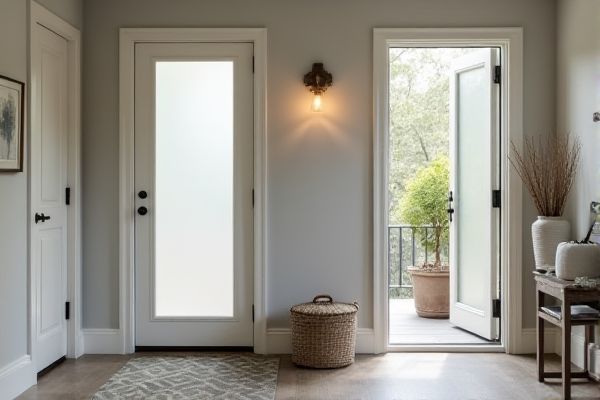
A mudroom frosted glass door offers enhanced privacy and conceals dirt and clutter, making it ideal for busy entryways, while a clear glass door allows natural light to flood the space, creating an open and airy feel. Discover which option best suits Your home's style and functionality by reading the rest of the article.
Table of Comparison
| Feature | Mudroom Frosted Glass Door | Mudroom Clear Glass Door |
|---|---|---|
| Privacy | High privacy, obscures view | Low privacy, fully transparent |
| Light Transmission | Diffused natural light | Maximum natural light |
| Style | Modern, sleek, subtle elegance | Classic, open, bright appearance |
| Maintenance | Less frequent cleaning needed | Requires frequent cleaning for smudges |
| Durability | Tempered/frosted glass ensures strength | Tempered clear glass for durability |
| Cost | Moderate to higher price | Moderate price |
| Application | Ideal for privacy-focused mudrooms | Best for bright, open mudroom areas |
Introduction to Mudroom Glass Door Options
Mudroom glass door options include frosted glass doors, which offer enhanced privacy and diffuse natural light, and clear glass doors that provide unobstructed outdoor views and maximize daylight flow. Frosted glass is ideal for maintaining confidentiality while adding a soft, modern aesthetic, whereas clear glass doors create an open, airy feel that visually expands the mudroom space. Selecting between frosted and clear glass depends on priorities such as privacy needs, natural light preferences, and overall design style for the mudroom.
Aesthetic Appeal: Frosted vs. Clear Glass
Frosted glass doors in mudrooms provide a soft, diffused light that enhances privacy while adding a modern, elegant touch to the space. Clear glass doors offer a sleek, open look that maximizes natural light and visually expands the area, creating a more airy atmosphere. Choosing between frosted and clear glass depends on the desired balance between privacy and natural light in mudroom design.
Privacy Considerations in Mudroom Design
Frosted glass doors in mudrooms provide enhanced privacy by obscuring visibility while allowing natural light to filter through, making them ideal for spaces connected to entryways or garages. Clear glass doors, though visually open and brightening the area, may compromise privacy by exposing the mudroom's interior to outside view. Your choice should balance the need for seclusion with the desire for light transmission, especially in high-traffic or closely situated outdoor areas.
Natural Light Transmission and Ambiance
A mudroom frosted glass door diffuses natural light, creating a soft, privacy-enhancing ambiance ideal for a cozy, inviting space. In contrast, a clear glass door maximizes natural light transmission, offering brightness and an open feel that visually expands your mudroom. Choosing between the two depends on whether you prioritize privacy and subtle lighting or an airy, sunlit atmosphere.
Cleaning and Maintenance Differences
Frosted glass doors in mudrooms hide dirt, fingerprints, and smudges more effectively, reducing the frequency of visible cleaning compared to clear glass doors. Clear glass doors require more frequent cleaning with streak-free glass cleaners to maintain a pristine, transparent appearance, as they easily show dust, dirt, and water spots. Both materials benefit from regular wiping, but frosted glass offers improved concealment of imperfections, making maintenance less demanding.
Security Features: Frosted vs. Clear Glass
Frosted glass doors in mudrooms offer enhanced privacy by obscuring visibility, reducing the risk of potential intruders assessing home interiors, which increases overall security. Clear glass doors, while aesthetically appealing and allowing natural light, expose the entryway to outside view, potentially compromising security by revealing home contents and occupant activity. Security can be further improved on both types with laminated or tempered glass options and reinforced locking mechanisms tailored for frosted or clear glass doors.
Energy Efficiency and Insulation Factors
A mudroom frosted glass door provides better privacy while offering moderate insulation against heat transfer, as the frosted surface can slightly diffuse light and reduce glare. Clear glass doors allow maximum natural light but often have lower energy efficiency, potentially increasing heat loss or gain unless treated with low-emissivity coatings. Your choice between these two affects indoor temperature regulation, with frosted glass typically contributing to improved insulation in colder climates.
Cost Comparison and Installation
Frosted glass doors for mudrooms generally cost more than clear glass doors due to the additional processing required to create the frosted effect, which increases material and labor expenses. Installation of both door types is similar, but frosted glass may require extra care to avoid damage to the delicate surface during handling. You should consider the slightly higher investment and careful installation needed for frosted glass if privacy and style are your priorities.
Best Use Cases for Frosted Glass Doors
Frosted glass doors in mudrooms provide enhanced privacy while still allowing natural light to filter through, making them ideal for entryways connected to private living spaces or home offices. They effectively conceal clutter or mudroom storage, maintaining a clean and stylish appearance without sacrificing brightness. Your choice of frosted glass is best suited for mudrooms where privacy and light diffusion are priorities, creating a balanced, functional barrier.
Best Use Cases for Clear Glass Doors
Clear glass doors in mudrooms are ideal for spaces where natural light flow and visibility between rooms are priorities, such as connecting the entryway to a living area. They enhance openness and create a seamless transition while allowing you to easily monitor activities or see outside conditions without opening the door. Clear glass doors work best in mudrooms with minimal need for privacy or where the aesthetic goal is to maximize brightness and maintain a modern, airy feel.
 homyna.com
homyna.com